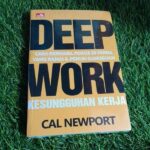In a world where endless notifications and constant digital noise dominate our lives, finding uninterrupted time for deep concentration can feel like a luxury few can afford. Picture a bustling coffee shop, where the clatter of mugs and snippets of lively conversations blend into a chaotic symphony. Amidst this chaos, imagine a person at the corner table, fully absorbed in their work, creating a new algorithm or crafting a piece of art with laser-like focus. This, my friends, is the essence of deep work. But what exactly is the “arti deep work”?
Read More : Deep Work Audiobook Free Download
The concept of deep work, which has become both a buzzword and a coveted skill, represents periods of intense focus devoid of distractions, allowing one to produce high-quality work efficiently. Coined by productivity expert Cal Newport, deep work is contrasted with shallow work, which encompasses tasks that are non-demanding and often performed while distracted. Understanding the “arti deep work” is crucial in this hyper-connected age, offering professionals a pathway to achieve more in less time and outperform their peers. So, why is deep work becoming the secret weapon in the modern-day work arsenal?
Imagine a secret sauce that empowers you to double your productivity while working fewer hours. Yes, the “arti deep work” might just be that sauce, epitomizing a focused state where the brain operates at full capacity, resulting in meaningful and creative output. This isn’t just theory; many high achievers swear by deep work as their cornerstone for success. From bestselling authors to top-tier coders, those who harness deep work’s potential report a profound impact on their careers and personal lives. It promises not just better results, but also enhanced well-being, as a focused mind often translates into a calmer and happier soul.
Unpacking the Benefits of Deep Work
Once you understand the “arti deep work”, the benefits are as compelling as a blockbuster movie. Research suggests that uninterrupted focus periods lead to improved learning, creativity, and job satisfaction. When our minds enter a state of ‘flow’, we’re more likely to produce groundbreaking ideas and solve complex problems. In contrast, multitasking can deplete productivity by up to 40%. Therefore, embracing the art of deep work is not just an option; it’s a necessary evolution for professionals aiming for the stars.
In today’s business world, the “arti deep work” has become synonymous with survival of the fittest. As companies constantly seek these top performers, individuals who can master focus are indispensable. The ability to concentrate deeply ensures you’re not just keeping up but staying ahead in this competitive race. Plus, adopting deep work techniques can also enhance mental health by reducing stress, as the brain is not constantly overwhelmed by digital noise. As we dive deeper into the ocean of deep work, its benefits appear as treasures waiting to be uncovered.
However, applying deep work in our routine is easier said than done. It requires commitment, patience, and well-formulated strategies. Breaking free from the chains of digital distractions is the first step in this transformative journey. Setting boundaries, such as dedicated work periods with phones on silent or utilizing technology to our advantage with focus-enhancing apps, can revolutionize our approach to work. Imagine turning your workspace into a zen sanctuary where creativity and productivity thrive seamlessly. It’s not just a dream—many have done it, proving the “arti deep work” can be a game-changer.
Strategies in Implementing Deep Work
To begin implementing deep work, it’s vital to first recognize when and where your focus is at its peak. Some are morning virtuosos, others might find late nights more conducive. Once you determine this, you can schedule your most challenging tasks during these periods. This is a key aspect of understanding the “arti deep work”. Be your own productivity coach, and design an environment that minimizes interruptions—think noise-canceling headphones, a tidy workspace, or even a ‘Do Not Disturb’ sign on your door. Like a superhero donning their cape, these tools arm you for the deep work battle.
Finding Balance: The Key to Deep Work
While the art of deep work is powerful, it’s equally important to find balance. One cannot sustain high levels of intense focus without breaks. Incorporating periods of rest, leisure activities, and social interactions ensures a well-rounded approach to productivity. Finding this equilibrium is just as essential in mastering the “arti deep work” as the work itself. After all, even the sharpest knife needs periodic sharpening lest it becomes dull. So, remember to recharge your mental batteries so you can return to the battlefield refreshed and ready to conquer new challenges.
Understanding and mastering the “arti deep work” can transform your professional life, leading to unprecedented achievements and personal satisfaction. It’s a skill that not only benefits you but can also inspire those around you. By adopting deep work practices, you’re not just improving your work ethic but also contributing to a more focused, calm, and productive world.
Key Goals of Embracing Deep Work
The Modern-Day Challenge of Deep Work
In the ever-competitive professional landscape, deep work has emerged as a defining factor of success. But what makes it so crucial today? The answer lies in the rapid technological advancements and the ensuing deluge of information. In a survey conducted by the University of California Irvine, it was found that an average office worker gets interrupted every 11 minutes, taking about 23 minutes to get back on track after each distraction. These statistics glaringly highlight why understanding the “arti deep work” is not just about ambition but essential survival in the corporate jungle.
Industry giants echo the sentiment that the ability to perform deep work is becoming increasingly rare, yet increasingly valuable. In a recent interview, Elon Musk attributed a part of his success to intensely focused periods where he locks himself away from the world, brainstorming spacecraft innovations. This skill—much like a Jedi’s mind trick—requires practice and dedication but promises the power to transform mundane output into exceptional results.
Once we’ve acknowledged its importance, the next step is the application of deep work principles. It requires discipline, much like training for a marathon, where consistent practice leads to endurance and performance. Start small by dedicating a short time each day to undistracted focus, gradually enhancing the duration as your mental muscles grow stronger. As with any new skill, patience is key—mastery takes time, but the rewards are well worth the effort.
The Psychological Benefits of Deep Work
There’s much more to the “arti deep work” than mere productivity gains. Delving into psychology, working deeply can bring heightened neuroplasticity—our brain’s ability to form new neural connections—which supports everything from problem-solving skills to emotional resilience. Dr. K. Anders Ericsson, a pioneer in expert performance research, highlighted that deliberate practice in deep focused states is what differentiates experts from amateurs.
Moreover, engaging in deep work is akin to meditation, as it trains our mental faculties much like a muscle. It fosters a sense of accomplishment and bolsters confidence. Emphasizing deep focus might also reduce anxiety, as losing oneself in a task can have a calming, grounding effect—especially crucial in our current age of information overload.
In essence, the psychological rewards are as compelling as the tangible outcomes. Imagine being able to look back at your work with pride, knowing you’ve poured your heart and soul into creating something truly remarkable. This emotional satisfaction is what drives the persistent growth culture associated with deep work.
The Ultimate Guide To Embedding Deep Work Into Everyday Life
Turning the “arti deep work” from a mere concept into everyday reality is indeed a challenging but attainable goal. The key is to integrate deep work like a habit, gradually and consistently. Start with identifying and curbing personal distractions—be it incessant email notifications or social media temptations. Every distraction averted is a step closer to a seamless deep work session.
Deploying practical tools can also bolster deep work efficiency. Consider using the Pomodoro Technique, dedicating 25-minute sessions of extreme focus followed by a short break. This rhythmic pattern conditions the brain to work in bursts of productivity, ensuring sustained energy and motivation. Furthermore, maintaining a designated workspace ensures your mind instantly associates the area with focus and creativity.
In conclusion, the journey towards deep work is a voyage as much about self-growth as it is about career progression, offering insights into personal strengths, weaknesses, and areas ripe for development. It’s a personal promise to embrace the potential lurking within, and the commitment to never settle for anything less than what you’re capable of achieving. So, take a deep breath, silence those notifications, and dive headfirst into the invigorating, rewarding world of deep work.
—
Integrate these practices into your workflow, and you might just start to see the world with new eyes—eyes trained to notice, capture, and create, all through the transformative “arti deep work”.


